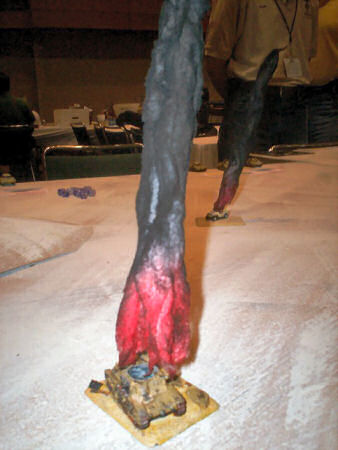OK, last time we had just finished our inking. Today, we are going to finish off the flesh and move onto the next bit. (I will figure out what the next bit is when I have to do it...)
Grab your mid-range Flesh again. And mix some with water, just like we did in Part One. This time we will be driving the brush about a bit more carefully, so hold off on drinking 16 cans of laager until later.

First we want to paint all the raised areas plain flesh. Yes, the ink could-of stained some of the first coat of flesh paint here slightly. No biggie, a 'normal' consistency of Flesh paint will just cover right over it. (See the pic above for what area I'm calling what.) Try and be a bit careful here, as we don't want to obscure all your inking in the dips and valleys. You will end up with what I like to call the 'catachan' look. Very, very bold in the dips 'n valleys.
Now if you like, you can stop right now and go on to painting the next bit (like the loin cloth). The fig will be tableworthy. But...we are using The Bartella Method, don't forget. That means any fool can do it - including you. So my advice is: griddle your loins and continue onto this slightly tricky bit. (If you think about it a griddle being a frying pan - skillet for the Yanks - this is one strange saying.)
Water down your Flesh until it's translucentish (that means it will give colour, but still show the colour under it). Sort of like when the significant other wears one of those white bras that cover the peaches, yet still lets you view them in all their glory. Now paint this on lightly into the dips (as opposed to the valleys or all-over-the-fig, though getting a bit onto the ridges won't make a lick of difference). You might have to give it a second or third coat to get it to look the way you want. My advice here is not to keep bashing away at the same bit, but roam all over the fig. You want that first coat dry to dryish before blasting it again, due to the paint being watery.
As you can see from the above and below pics, it gives you a neato gradual transition from light to dark. (This might be what that blending malarky is all about. Let me know what other people call it.)
Now here is a sorta tricksy bit
If you think some of your valleys are a bit too dark. (In my case, the sixpack.) Then use even more watery paint (or just one coat, depending on your consistency) and carefully paint it on that valley. You still want it darker 'n the dips, but lighter 'n the deep valleys. If you then make it too light (as I did), then get some very watery ink and paint over that bit. (Wait for it to dry a little first!) Eventually it will look 'right.'
Here are the other pics of this technique:

The first one is a before-shot showing the inked fig.

OK, now here is the after-shot. Note how the ink has been cleaned up real nice-like.
OK - Time for some Highlighting
Get your mid-range Flesh again, and some White.
Mix it to this-sort-of-colour. (Yes, that is a bit vague, isn't it? That's so I can break you out of thinking you must buy Ostragoth Flesh, Hobbit Flesh and Tanning Salon Brown to paint some skin.)
Anyways, back on track. Look Below:

Something sorta-like-that will get you over the line, folks. Don't get too bunched up over it. Just go with the flow. (Use the force, Luke!)

Now paint it onto the upper 2/3rds of each ridge, like so. With stuff like the fingers and thumbs and the six-pack muscles, do the entire ridge. If you put a little too much on, then just use a bit of normal Flesh to make the lighter area smaller. This colour is also great for lightening up a valley or dip if needs be. Just use the watery method as explained earlier.
Now before I forget
We must also give my Dad a cheer for lending me his camera so all this could be possible. What a swell guy the Old Man is!
Sorry for almost forgetting you, Dad. My bad.

Another pic of the same thing.
Now the best advice I can give on this and the following bit is - Don't be anal! Seriously, dude, unclench yer butt. If you do a little more 'n 2/3rds or a little less…..so freeking what! Firstly, this is meant to be fun, and secondly, it will still look just fine, OK? Mine were a little more in some places and a little less in others. Just use yer eyes and go with what looks good.
OK - now we are ready for the finalish highlight
(There will be a bit of fine detailing later, but for now this much is fine and dandy.)
Once again, get the Flesh and White out. Mix some of each together until you get this-sort-of colour.

Now once again, something similar will be just fine, OK?
So basically we are looking at 3 different tones, each successive one lighter 'n the other by mixing a little more white each time. Yep, it's that easy.

Now set to work on the highlights on the peaks - i.e., the tops of the ridges - like so. (Think like a kid's pic of a mountain: We are only painting the bits the snow falls on.) With some bits - like the sixpack and fingers - I did about 80% of the ridge instead of just the peak. We will paint the peaks in the very final highlight-and-clean-up stage.
Here are some more pics to help you out with this bit:




OK, I reckon that's enough for now. Next lesson we will mix up our own colours, make a mistake, fix the mistake, use paint as a wash, and generally make the infected flesh look infected. (You don't have to repeat my mistake - I'm just going to keep it in, so you know anyone can stuff up and recover from it like a little ripper.)
While I'm still at it:
If you don't get something I'm talking about, or you need more help with something, let me know and we will see if we can get it sorted for you. Also for those that have done all this before (and even done a better job of it): Jolly good. This is to help the "Orange Space Marine sect" catch-you-up and gun-you-down in the next painting comp they enter. Or even (God forbid!) slap something neat on the table next game.










